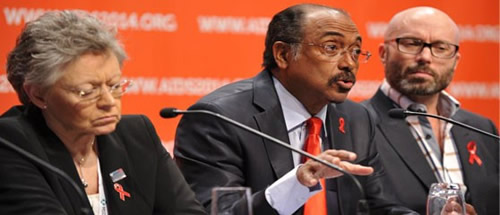
|
Bleak Outlook for Global Fight Against HIV/AIDS Among Drug Users

UNAIDS Director Michel Sidibé speaking at the International AIDS Conference, 2014
7 August 2014 by Florence Keen
Despite declarations that we are within touching distance of eradicating HIV/AIDS, without a more concerted effort and further investment in combating the disease among injecting drug users this will never become a reality, a recent report has outlined.
In 2011, The White House boldly declared that for AIDS, it was the "beginning of the end". Such rhetoric is becoming increasingly familiar, seen recently at the 20th International AIDS conference in Melbourne in July, when in his opening address Michel Sidibé, executive director of UNAIDS, called for an end to AIDS by 2030. Here, UNAIDS presented the conference with their recent publication, The Gap Report, where they state their commitment to "leaving no one behind".
Yet, looking specifically at global efforts to tackle HIV/AIDS among injecting drug users (IDUs), it is all too apparent that this goal may be unachievable, as there appears to be a disconnect between what multinational organizations claim they can accomplish, and what the situation is in reality; one that is marked by a lack of investment and is on the brink of deterioration if certain issues are not addressed.
By UNAIDS' own estimate there are currently 12.7 million IDUs globally, of which 13 percent (over 1.6 million) have HIV. Among affected populations -- sex workers, gay men who have sex with men, transgender people, among other groups -- IDUs have one of the highest prevalence rates of HIV. According to Harm Reduction International's (HRI) 2012 report, 30 percent of HIV infections outside of sub-Saharan Africa can be attributed to injecting drug use, and in certain parts of Central Asia and Eastern Europe this has risen to a staggering 80 percent.
A recent report -- titled The Funding Crisis for Harm Reduction, and written by HRI, the International Drug Policy Consortium (IDPC), and the International HIV/AIDS Alliance (IHAA) -- warns of a global funding crisis in the response to HIV/AIDS, and states unequivocally that there can be no "end to aids" unless there are targeted efforts for IDUs which encompass all aspects of harm reduction. It is estimated that $2.3 billion annually is required to fund HIV prevention among IDUs; however, recent annual figures from this report reveal that only around $160 million was spent on them -- 7 percent of what is needed. Conversely, global drug enforcement exceeds $100 billion annually, despite the overwhelming evidence that punitive measures exacerbate health crises among affected groups.
As the aforementioned report outlines, this funding crisis is due in part to the changing face of international donor policy. The global budget for combating AIDS is now predominately focused on low-income countries, leaving middle-income countries ineligible. Donors are retreating under the premise that these countries are wealthy enough to support their own responses. The issue, however, is that that approximately 75 percent of IDUs live in middle-income countries such as China, Thailand, Pakistan and Russia, countries that have some of the most draconian drug laws in the world and in some cases refuse to fund harm reduction programs in any shape or form. This is despite the compelling evidence that the combined implementation of needle exchange programs, opioid substitution therapy (OST) and anti-retroviral treatment (drugs that suppress the HIV virus) is highly effective. For example, in areas such as Xichang City, Sichuan Province in China, the Gap Report showed how harm reduction strategies were implemented successfully across this region since 2004, and the rates of HIV subsequently dropped by 75 percent. A general unwillingness to invest is an attitude that is rooted in old stigmas attached to drug users.
Indeed, according to the United Nations Office on Drugs and Crime's (UNODC) 2014 World Drug Report, only 79 out of 192 reporting countries offered opioid substitution therapy and only 55 offered needle exchange programs. In some countries in Eastern Europe, for example, the proportion of IDUs with HIV who receive or have access to anti-retrovirals stands at less than 1 percent compared to 86 percent in Western Europe. The report emphasized that people who inject drugs are falling far behind other groups who live with HIV in accessing the right treatments.
Finally, concern is rife that the post-2015 Development Agenda will not carry on with the UN's Millennium Development Goals that was introduced in 2000 and is what catalyzed efforts to combat HIV/AIDS. In July, The Economist reported that previous goals are no longer being explicitly mentioned, and that investment is unlikely to rise over the next few years. "Those fighting AIDS", they write, "must learn to do more with less."
###
Source: TalkingDrugs http://www.talkingdrugs.org/bleak-future-global-fight-hiv-aids-drug-users
For more HIV and AIDS News visit...
Positively Positive - Living with HIV/AIDS:
HIV/AIDS News
|